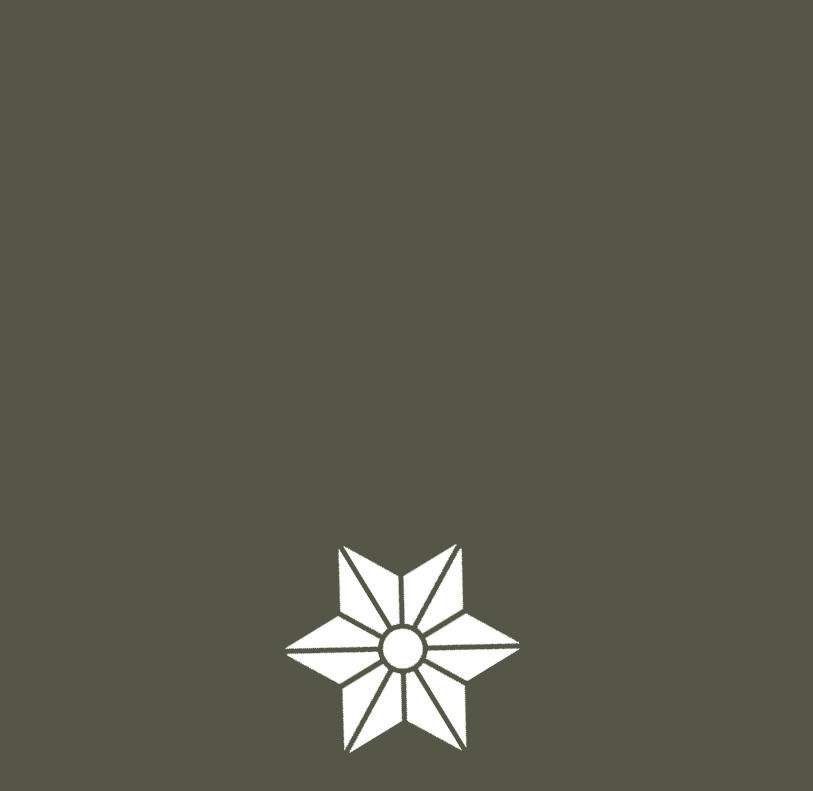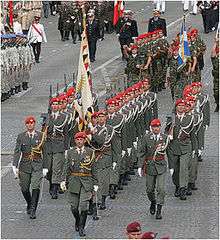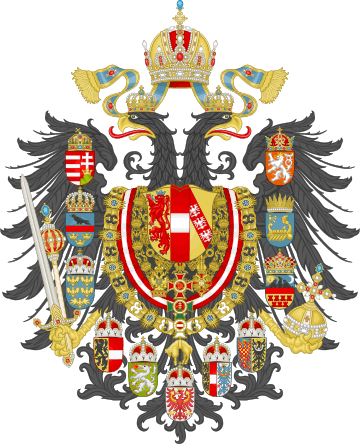Waffenfarbe (Austria)
- This article incorporates information from the equivalent article on the German Wikipedia.
Waffenfarbe(n), also Egalisierungsfarbe(n) (en: corps colours, or egalisation colours | i.e. colours to, on, or/and of service uniforms), are traditional used by the Federal Army of the Republic of Austria (de: Bundesheer der Republik Österreich). The collar patches (de: Kragenspiegel) of the Federal Army report traditional the rank and are also used in the police. However, any defined (particualar) corps - or egalisation colour is always in correspondence to the appropriate arm of service, unit or formation.
- See also
Introduction
With the formation of the Austrian Federal Army of the first Republic (de: Bundesheer der ersten Republik) in 1920/21 the German Reichswehr uniforms and Waffenfarben (corps colours) were adopted as well. However, slight different were only the Grasgrün (en: grass-green) of the Austrian infantry (Reichswehr – white) and the Gelbgrün (yellow-green) of the Austrian hunter troops (Reichswehr – hunter-green). Late in 1933 a new uniform was introduced by almost close orientation to the Austro-Hungarian Land forces 1867-1914. The so-called k.u.k. "Adjustierungsvorschrift" (en: service dress instruction) contains the colour pattern tables from the year 1912 and regulated the Egalisierungsfarben to be worn.
Austrian corps colour today
In Austria collar patches (de: Kragenspiegel) of the Bundesheer (Federal Army) report traditional the rank and the arm of service. They are also used in the police. The corps colours dominate the basic colours of the rank insignia.
Synoptic table and examples
The table below contains some corps colours and examples, actually used by the Bundesheer.
| Troops, unit, appointment | Caps colour | Example (Paroli) |
Remark | |
|---|---|---|---|---|
| Guards | scharlachrot mit weißem Vorstoß (en: scarlet(-red) with white edging strip) |
 |
Oberstabswachtmeister (OR-8) | |
|
gelbgün (yellow-green) |  |
Korporal (OR-3) | |
| Jäger (rifleman) |
grasgrün (medow green) |  |
Oberleutnant (OF-1a) | |
|
schwarz (black) |  |
Leutnant (OF-1b) | |
| Aufklärer (reconnaissance) |
gelb (yellow) |  |
Stabswachtmeister (OR-7) | |
| Theresian Military Academy | rot (red) |
 |
Fähnrich (OF-D) | |
|
rot (red) |
 |
Offizierstellvertreter (OR-9) | |
| Engineer troops | stahlgrün (steel green) |
 |
Zugsführer (OR-4) | |
| NBC-Defence | hechtgrau (pike grey) |
 |
Zugsführer (OFR-2) | |
| Communicatiors | rostbrau (rust browen) |
 |
Vizeleutnant (OR-9) | |
| Aviators (e.g. pilots) |
violett (violet) |
 |
Wachtmeister (OR-5) | |
| Technical service | brau (browen) |
 |
Hauptmann (OF-2) | |
| Higher mil. technical service | braun mit rotem Vorstoß (en: browen with red edging strip) |
 |
||
| Higher mil. expert service | rot-blau (en: red blue) |
 |
Major (OF-3) | |
| General staff service | red-black |  |
||
| Intendance service | green deep-red |  |
||
| Logistic | deep-blue |  |
||
| Mil. human medicine service (phycisian) | blue black |  |
Oberstabsarzt (OF3) | |
| Mil. veterinary service (veterinarian) | deep-red black |  |
Oberstveterinär (OF-5) | |
| Mil. chemist's service (pharmacist) | lilac black |  |
||
| Medical service | sky blue |  |
Oberwachtmeister (OR-6) | |
| Wirtschaftsdienst (admin. service) |
light blue |  |
Oberstleutnant (OF-4) | |
| General officers | gold (colour) |  |
General (OF-9) rank insinia on peaked cap left | |
| basic colors of the uniforms |
|
 |
 | |
Synoptic table and examples to beret colours
One of the features of person in uniform of the Austrian Bundesheer is the beret. Normally, it will be worn to the dress uniform or on special occasions to the field suit. Exempted are only members of the Air Force and the Gebirgsjäger (en: mountain infantry) with an own headgear. The colour of the particular beret corresponds to the appropriate branch of service and/or the particular unit or formation. The colour of the Bundesadler (en: federal eagle) and the eagle double-wing on berets is as follows:
- grey metallic - recruits and chages (OR-1 to OR-4)
- silver - NCOs (OR-5 to OR-9)
- gold - officers (OR-1 to OF-5)
- gold on red background - general officers (OF-6 to OF-9)
| Troops, unit, appointment | Caps colour | Example | Remark, mainly use | |
|---|---|---|---|---|
|
jaegergreun (rifleman-green) |
| ||
|
schwarz (black) | members of the armored corps, most members of the 3rd - and 4th Mechanized infantry brigade. The image shows an armored officer´s beret with golden federal eagle | ||
| Garde (guards) | scharlachrot (scarlet-red) | members of the Guards batallion | ||
| Red beret | rot (red) | members of 25th Jaegerbataillon in Klagenfurt. | ||
| Coral-red beret | Korallrot (coral-red) | members of the military patrols and military police | ||
| Rusty-brown beret | Rostbaraun (rusty-brown) | members of the combat support troops | ||
| Pike-grey beret | Hechtgrau (pike-grez) | members of the NBC-defence school and the "Austrian Forces Disaster Relief Unit" | ||
| Dark-blue beret | Dunkelblau (dark-blue) | members of the Army logistics school, Combat support command (with all subordinate elements), and the Military medical centre | ||
| Yellow-green beret | Gelbgruen (yellow-green) | Federal army top-performance athletes (de: Bundesheer-Leistungssportler) of the Army sports centre (de: Heeres-Sportzentrum) | ||
| Olive-green beret (with federal eagle) |
Olivegruen (olive-green) |
members of the Skirmishing command (basic level – characterised by the federal eagle) | ||
| Olive-green beret (with Skirmishing patrol badge) |
members of the Skirmishing command that passed the basic Skirmishing command trainings course (advanced level – the federal eagle is replaced by the Skirmishing command badge) | |||
| Blue UN-beret | UN-blue | soldiers on duty to -, contract of -, or by order of the United Nations. | ||
Federal Police
The Bundespolizei uses corps colours on the so-called distingtion (en: rank insignia) and peaked cap (de: Tellerkappe):
- usually and police paspore: Krapprot
- higher service (police legal advisor and poblic health official): Bordeauxviolett (bordeaux red)
K.u.k. Egalisation colours

The so-called "Adjustierungsvorschrift" (en: service dress instruction) contains the colour pattern tables from the year 1912. The name ″Egalisierung″ consists of uniform coloure at the one hand, and corps colour, egalisation colour (de: Waffenfarbe) or badge colour at the other hand. The system was extremely complicated and was called by slang Farbkastel (en: paint boxlet). Ultimately, in the k.u.k. common army it was very difficult to distinguish the 102 infantry regiments from Hussars, Lancers or Dragoons, as well as services, service branches, specialm services, appointments, etc.
- Farbkastel (egalisation colours) of the k.u.k. armed forces
-
.png)
table 1
-
.png)
table 2
-
.png)
table 3
-
.png)
table 4
-
.png)
table 5
-
.png)
table 6
- See also
- Main article: Rank insignia of the Austro-Hungarian armed forces
See also
- Wehrmacht ranks and insignia
- Corps colours of the Heer (1935–1945)
- Corps colours of the Luftwaffe (1935–1945)
- Corps colours (Waffen-SS)
References
- Glossary of German military terms
- Adolf Schlicht, John R. Angolia: Die deutsche Wehrmacht, Uniformierung und Ausrüstung 1933-1945
Vol. 1: Das Heer (ISBN 3613013908), Motorbuch Verlag, Stuttgart 1992
Vol. 3: Die Luftwaffe (ISBN 3-613-02001-7), Motorbuch Verlag, Stuttgart 1999
(very detailed information and discussion but no coloured images)
Sources
- Schriften des Heeresgeschichtlifhen Museums in Wien Das k.u.k. Heer im Jahre 1895 Edition Leopold Stocker Graz
1997 ISBN 3-7020-0783-0
- Rest,Ortner,Illming Des Kaisers Rock im 1. Weltkrieg Edition Militaria Vienna 2002 ISBN 3-9501642-0-0

